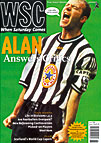 A controversial game in New York provided a taste of what we can expect from referees at the World Cup, as Nick Patience explains
A controversial game in New York provided a taste of what we can expect from referees at the World Cup, as Nick Patience explains
Watching the New York/New Jersey Metrostars play the San Jose Clash on April 25th, it quickly became apparent the referee – literally, for once – was watching a different game to the rest of us. There were seven goals, three red cards, eight yellows and 17,380 fans in Giants stadium wondering what would happen next, and why what had happened previously had happened at all. In a game that swung one way then the other, the much-maligned Alexi Lalas, in his first season with New York, scored the winner with just 11 seconds to go, which in most fans’ opinion was the only thing he did right in the entire game.
Afterwards, for their personal safety, the referee and his assistants had to be escorted from the ground by security at the opposite end to the exit and away from the 100 or so supporters’ club members, segregated as if they represent some sort of security threat.
The prime suspect in this mystery was FIFA, and the motive: the alleged testing on the MLS of the tackle-from-behind rules due to be imposed during the World Cup. The Metrostars started nervously and were one down after just ten minutes, albeit from an admittedly superb free kick by Eddie Lewis, looped over a static Tony Meola. But then things started to get a little weird. San Jose’s Wade Barrett tackled Metrostars’ striker Giovanni Savarese from behind on the right, about half way inside the San Jose half. It was a nasty tackle, and definitely worth a yellow card. But a red? Referee Rich Grady thought so. We put it down to FIFA using the MLS as a test-bed for the kinds of experiments normally reserved for short youth tournaments, and it seems we were not alone.
Later that day, the game between Los Angeles Galaxy and Tampa Bay Mutiny saw two players sent off for apparently innocuous challenges. LA’s coach Octavio Zambrano said after the match: “The game has changed so much in two weeks, I’m baffled.” He wasn’t the only one.
Reports the next day in the New York Times focused on Lalas’s late winner, the topsy-turvy nature of the game and the second-half introduction of Tab Ramos, back after a knee injury. But on Monday, the Times ran a Reuters report citing the teams’ confusion on the crackdown on hard tackling, which it said was a FIFA experiment ahead of the World Cup. Then why did the tackle from the front in the second half by the Metrostars’ first scorer, Rooney, and the innocuous trip by LA’s Danny Pena in the other game, result in early baths? Inconsistent refereeing perhaps? However, the MLS pointed to refereeing inconsistencies as a reason for introducing the new rules – it talked about the “peculiar individuality” of some of the refs.
The league claims it had told all 12 MLS teams explicitly during “Spring training” in February precisely what would result in a red card and what would not. A senior league official had trawled through videos of the games from the first two seasons and compiled a grizzly compilation of fouls to make Vinnie proud, showing tackles that would now warrant red cards. And this was done about a month before FIFA’s directive was issued, which the league described as “vague and subjective”. It just so happens the MLS was the first league to start after the FIFA directive, and so everybody – including the fans, newspapers and many of the teams – assumed it was all down to FIFA.
This begs the question that if, as the league claims, all the officials, coaches and players have seen this video, and every referee watches it before every game (the teams also have the opportunity, but it’s not compulsory) why was everyone so surprised at what happened?
There are only 12 teams in the league, and only about four languages spoken. What’s going to happen in France, where there are 32 teams and more language barriers to overcome in a much shorter space of time? Admittedly, FIFA’s new rule only penalizes tackles from behind, so there is less room for interpretation.
The MLS apparently made its move to avoid the public perceiving football to be a dirty game and, this being America, it can cite statistics to demonstrate the effect of the attempted clean-up. This season’s average is a red card every 2.5 games, against one every five in the first two seasons. So we’re heading for double the amount of red cards than before at this rate, although may settle down a bit as the season wears on.
If a few weekends of craziness are anything to go by, Glenn had better dig out his “100 Best Tackles From Behind” video and take a gander. He’ll thank me for it.
From WSC 136 June 1998. What was happening this month